New micro-shunt device facilitates aqueous outflow
Patients with at least one prior failed incisional glaucoma procedure showed a 33% reduction in IOP at 1-year follow-up.
 Diamond Y. Tam |
 Ike K. Ahmed |
Physiologic aqueous outflow pathways include the conventional outflow pathway and the uveoscleral outflow.
Whereas surgical procedures such as canaloplasty and trabecular bypass stents aim to enhance conventional outflow, new devices such as the Gold Micro-Shunt implant (Solx) augment aqueous outflow into the suprachoroidal space from the anterior chamber.
Two models — the GMS and the GMS Plus — differ in size and width of the drainage channels, with the latter being larger. The shunt consists of two leaflets fused together, vertically concealing channels in the body of the device that connect the anterior openings to the posterior openings. The width of the channels in both models is 25 µm. However, the height of the channels in the GMS model is 44 µm compared with 68 µm in the GMS Plus.
Procedure
Insertion of the shunt begins with a fornix-based conjunctival peritomy of about 4 mm in the area of intended shunt placement with an anterior lip of conjunctiva left behind. A horizontal scleral incision of about 3.5 mm is then fashioned, usually 2 mm from the limbus, and carried out to a near full-thickness depth, where the blue hue of choroid is visible through a thin layer of sclera.
This incision may need to be more posterior in highly myopic eyes or eyes with large anterior segments. Intraoperative gonioscopy can also be useful to assist in ascertaining that the incision is created at the appropriate distance from the limbus.
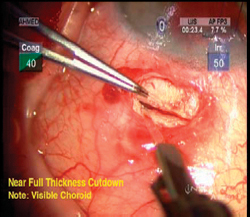 A 95% thickness scleral cut-down is created after a conjunctival peritomy to set the depth for the scleral tunnel incision. |
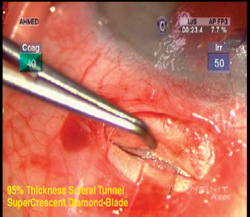 A scleral tunnel incision is created forward to fashion the pocket in which the shunt will sit. |
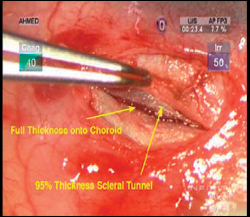 A full thickness incision has been made, and choroid is visible at the posterior edge of the scleral tunnel incision. |
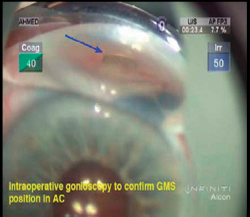 Gonioscopy is a helpful adjunct during surgery to assess the position of the shunt in the anterior chamber. |
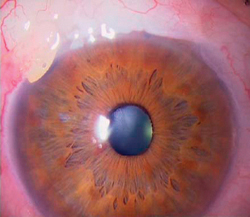 A postoperative slit-lamp photograph of a patient with the shunt visible. Note also the failed subconjunctival filter superiorly. |
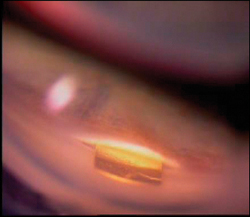 A postoperative photograph using a gonioscopy lens to view the shunt. Images: Tam DY, Ahmed
IK |
A deep 95% thickness scleral tunnel is carried forward until the scleral spur is then performed without entering the anterior chamber. A separate corneal paracentesis incision should then be made to decompress the eye. The remaining thin layer of sclera overlying the choroid at the base of the initial incision is then cut, exposing the choroid.
A minute volume of suprachoroidal lidocaine should then be carefully administered with a blunt cannula posteriorly, along with a small volume of suprachoroidal viscoelastic. Through the previously created paracentesis incision, the anterior chamber is formed with viscoelastic, most importantly in the area of the anticipated shunt placement.
A horizontal entry is then made into the anterior chamber at the level of the scleral spur through the previously created scleral tunnel incision. The shunt is then brought onto the field and positioned in the scleral pocket incision.
Pushing the implant forward so the posterior edge clears the scleral incision and then tucking the posterior edge into the suprachoroidal space enables correct positioning. The anterior aspect of the shunt should be positioned in the anterior chamber while the posterior aspect rests in the suprachoroidal space posteriorly.
A 27-gauge needle or Sinskey hook may be used to manipulate the shunt both externally and through the anterior chamber to achieve the desired position.
The anterior aspect of the shunt is crescent-shaped with a positioning hole in which a Sinskey hook can be placed to assist with positioning. With an intraoperative gonioscopy lens, the anterior drainage openings should be visible and clear of angle structures. The posterior drainage openings should also not be visible externally and completely located in the suprachoroidal space.
Once satisfactory position has been achieved, the scleral incision should be closed in a watertight fashion using interrupted 10-0 nylon sutures, typically four or five sutures. The conjunctiva is then closed with a running horizontal mattress suture using 10-0 Vicryl suture with a vasectomy needle, again in a watertight fashion.
Early results promising
The Gold Micro-Shunt is a new device designed to enhance uveoscleral outflow by providing a conduit for aqueous to exit the anterior chamber, through the shunt and into the suprachoroidal space.
Early experience appears to show a high safety profile with reasonable efficacy. Data that have been released by Solx in patients with at least one prior failed incisional glaucoma procedure showed a 33% reduction in IOP at 1-year follow-up of 39 patients who received the GMS model with a preoperative IOP of 27.4 ± 4.7 mm Hg as compared with 18.1 ± 4.7 mm Hg postoperatively. Forty patients who received the GMS Plus model showed similar IOP reduction from 25.5 ± 6 mm Hg to 18 ± 2.5 mm Hg.
Topical medication usage was also decreased in the GMS group from 1.97 ± 0.74 to 1.5 ± 0.94, while the GMS Plus group began preoperatively at 2.25 ± 0.84 and decreased medication usage to 0.85 ± 0.9 at 1-year follow-up. Studies are currently under way to determine its efficacy and safety profile as compared with traditional surgical approaches.

- Ike K. Ahmed, MD, FRCSC, can be reached at Credit Valley EyeCare, 3200 Erin Mills Parkway, Unit 1, Mississauga, Ontario L5L 1W8, Canada; +905-820-6789; fax: +905-820-0111; e-mail: ike.ahmed@utoronto.ca. Dr. Ahmed is a consultant for Solx.
- Diamond Y. Tam, MD, can be reached at diamondtam@gmail.com. Dr. Tam has no direct financial interest in the products discussed in this article, nor is he a paid consultant for any companies mentioned.
